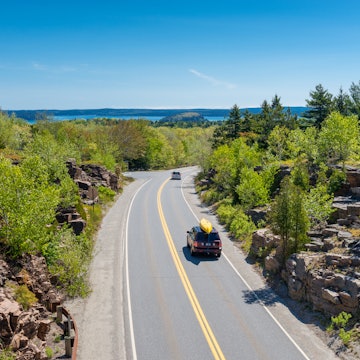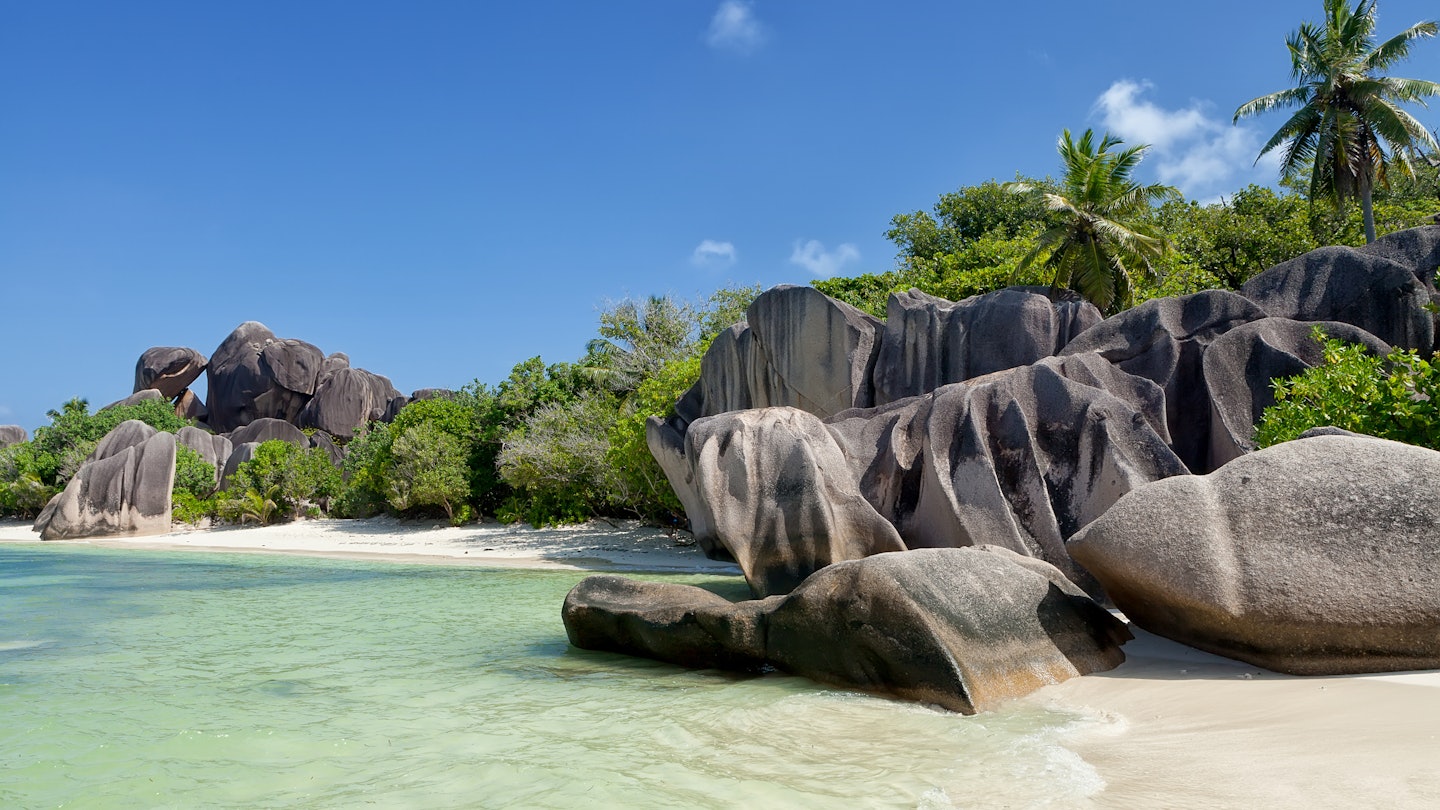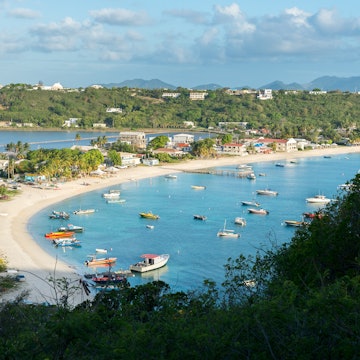
Places that rock: coastal formations that will knock your socks off

May 30, 2018 • 6 min read

Supernatural shapes guard the beach on this corner of La Digue in the Seychelles. Yamagiwa / Shutterstock
It’s a hard time to be a coastal rock formation. Malta’s Azure Window collapsed into the sea in 2017. There are now only eight of the 12 Apostles left on the Great Ocean Road. New Zealand’s Elephant Rock lost its trunk in a 2016 earthquake.
But for geology fiends and lovers of seaside scenery, the world still has plenty of weird and wonderful rock formations to enjoy. Here are 10 of our favourites.
Durdle Door – Dorset, England
This natural limestone arch on Dorset’s Jurassic Coast rather resembles a sea serpent taking a drink. It’s one of England’s most beloved natural wonders, drawing droves of photographers and picnickers to the adjacent pebble beach in warm weather. Its name comes from the Old English ‘thirl’, meaning ‘pierce’ or ‘drill.’ To get here, park at the top of the cliffs and clamber down, or hike the one-mile coast path from Lulworth Cove. The entire region is host to interesting limestone formations: just west of the Durdle Door you’ll see a line of jagged islets nicknamed the Bull, the Blind Cow, the Cow, and the Calf.

Yehliu Geopark – Taiwan
On a spit of land jutting into the East China Sea, Yehliu is a fairyland of mushroom-, dragon- and tree-shaped rock formations that could easily double as a far-off planet in a sci-fi flick. The formations are technically known as ‘hoodoos’, which occur when soft rocks like sandstone are topped with harder volcanic rock. The soft rock erodes, leaving thin columns with bulbous tops. Must-Instagram formations include Elephant Rock, Fairy Shoe and Queen’s Head, the latter so-called for its resemblance to a regal profile. Afterwards, head to the row of seafood restaurants outside the park to feast on anything that swims.
Punakaiki Pancake Rocks – South Island, New Zealand
On the rough-hewn northwest coast of New Zealand’s South Island lies one of the world’s great geological roadside attractions. These cliffs of stacked limestone, formed 30 million years ago from decayed marine plants and animals, are otherworldly on their own. But when the angry grey sea surges, water explodes through blowholes in the rocks, shooting high in the air and spraying anyone nearby. The cliffs are accessible via an easy 20-minute loop track. Visit during stormy weather for the most dramatic surges. If you’re lucky you’ll spot dolphins breaching in the cold waters below.
Source d’Argent Beach – Seychelles
Enormous, crenellated granite boulders guard the edge of this powdered sugar-sand beach like a herd of ancient elephants. The rocks lend a wild air to the location, on the southwest coast of the island of La Digue. Snorkel the warm, shallow waters in the boulders’ shadows, looking out for sea turtles and keeping your feet well clear of sea urchins. Afterwards, stretch out on the sand with a fresh coconut and an eye on the emerald hills of nearby Praslin Island on the horizon. Be sure to visit at low tide; high waters can essentially swallow the beach.

Arch of Cabo San Lucas – Baja California Sur, Mexico
At the tippy-tip of the Baja California peninsula where the Gulf of California kisses the Pacific lies this stunning natural arch, known locally as ‘El Arco’. Another name, ‘Land’s End’, is appropriate for the location, unreachable by road. Get here via a glass-bottom boat tour or sunset catamaran cruise from the nearby marina. The ambitious can kayak here as well – but beware rough seas on the Pacific side. Formed by wind and water erosion over millennia, the arch is a hot spot for colonies of boisterous sea lions. When you’re done, feast on tacos and sip small-batch mezcal in stylish Cabo San Lucas.

The Remarkable Rocks – Kangaroo Island, South Australia
Wind and waves coming off the Indian Ocean took some 500 million years to carve these granite boulders into the remarkable shapes you see today. Looking rather like Henry Moore sculptures, all enormous curves and womb-like hollows, the rocks are swirling blends of mica, quartz and feldspar, topped with rust-like orange lichen. Sunset is an excellent time to visit, when the lichen glows gold in the waning light. Equally remarkable is the rest of Kangaroo Island, with beaches of fat, happy seals, fields of fragrant lavender and colonies of tiny blue fairy penguins.

Hopewell Rocks – New Brunswick, Canada
Off the thickly forested coast of New Brunswick in Canada’s Bay of Fundy, these towering sandstone pinnacles – many of them topped with trees – can be experienced in two totally different ways. At low tide the water recedes completely, allowing you to wander the seabed for more than a mile, gawking upward at formations with nicknames like Lover’s Arch and Dinosaur Rock. At high tide, deep water allows kayaking amidst the rocks and exploring hidden coves. Formed by thousands of years of ice and rain, these monoliths are not as eternal as they look: one beloved formation, Elephant Rock, came crashing down in 2016.

Giant’s Causeway – Northern Ireland
Legend has it that this singular rock formation was built by the fabled warrior giant Fionn mac Cumhaill, who used it as a bridge to get to Scotland. In reality, these 40,000 interlocking basalt columns, leading from the coast of County Antrim out to sea, was formed by ancient volcanoes. Today the Giant’s Causeway is one of Northern Ireland’s top tourist draws. Avoid parking and fees by strolling there from the town of Bushmills, a 45-minute walk with glorious views over the crashing North Atlantic. Walk out onto the causeway itself to snap photos and marvel at the ancient geology.
High Island Cliffs – Hong Kong
Think of Hong Kong and you’re probably visualising streets of blinding neon, the sky hardly visible above the high-rises. But a quick drive from the teeming city centre is a coastal landscape about as un-urban as you can imagine. These are the cliffs of High Island, close-packed towering hexagonal columns formed 140 million years ago from the lava flows of vast underground volcanoes. Today it’s a Unesco geopark and popular hiking area, with views over the tropical-green seas to jungle-shrouded nearby islands. After exploring the cliffs, taxi over to Sai Kung town for a seafood feast.

The Glass Window – Eleuthera, Bahamas
The pink sand paradise of Eleuthera in the Bahamas is so narrow you can feel the sea breeze blow from both east and west. At its middle, the island tapers to an impossibly skinny 30 feet. This isthmus is known as the Glass Window, and it’s famous for its startling views: on one side lies the pale, calm Caribbean Sea. On the other tumbles the navy Atlantic. Scramble up the nearby bluffs for the best view, taking extra care on windy days. Afterwards, take a dip in the Queen’s Baths, a series of sun-warmed rock pools carved out of the craggy rocks.
https://shop.lonelyplanet.com/products/secret-marvels-of-the-world-1/













